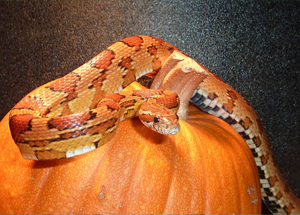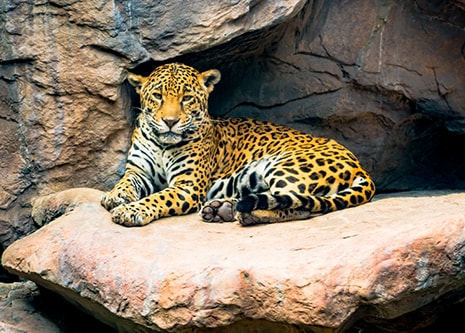
- VisitSupport Happy HollowDONATE TODAYExploreSupport Happy HollowDONATE TODAYLearnSupport Happy HollowDONATE TODAYSupport
-
Today's Hours: 10:00 am to 5:00 pm
Zoo on the HillCorn snake

Scientific name: Pantherophis guttatus
Family: Colubridae
Order: Squamata
Class: Reptilia
Range: Southeastern United States
Habitat: Grassland, shrubland, temperate forest, wetlands
Lifespan: 6 to 8 years old in the wild; over 20 years in captivityWhat do they look like?
Corn snakes have long, narrow bodies with defined heads. Adults can reach a length of three to six feet. Wild corn snakes are usually orange with red markings on their backs, outlined in black. Their bellies are white and black checkered. The corn snake has weakly keeled scales, giving them a semi-glossy appearance.How do they behave?
Corn snakes are primarily nocturnal (most active at night) although this can vary depending on the climate. Corn snakes are ectothermic (they must acquire their heat from their environment). They prefer to live in overgrown fields, sparse forests, abandoned buildings or farmlands. They are predominantly terrestrial, meaning they live on the ground, though they are able to climb trees or cliff sides if needed.What do they eat?
In the wild, corn snakes eat rodents, lizards, frogs, birds and eggs. These snakes are not venomous, instead they kill their food using constriction. At Happy Hollow, they eat mice.How are they born?
Corn snakes breed after a winter cooling period, called brumation (a state in which reptiles slow down their metabolism and become inactive to survive periods of cold weather). Brumation lasts 60-90 days in this species and allows the female to prepare for breeding. Female corn snakes lay their eggs approximately one month after mating and can lay 12-24 eggs at a time. Unlike bird eggs, corn snake eggs are soft and leathery. After laying the eggs in a warm, moist, concealed area, the female abandons them, leaving them to hatch on their own. Around 10 weeks after the eggs are laid, the young snakes use a specialized egg tooth to break open the shell and emerge from the nest. The newly hatched snakes are precocious (they are able to survive on their own without help from their parents).What should you know about them?
The name “corn snake” originated when farmers stored ears of corn in wooden buildings. These buildings provided corn snakes a perfect habitat with plenty of shelter and a continuous source of mice and rats, which come to feed on the corn.Conservation
The corn snake’s conservation status is currently listed as Least Concern by the International Union for Conservation of Nature. Although corn snakes are at stable populations in the wild, they are still sometimes caught for the pet trade. Wild-caught animals will often refuse to eat in captivity and can carry parasites. If you are considering a corn snake as a pet, make sure to do your research and consider adopting from your local animal shelter or reptile rescue group.For more information on reptile rescue in the bay area check out the Bay Area Amphibian and Reptile Society at www.baars.org

Zoo in the Hollow
Follow the crooked bamboo pathway down into the hollow and visit with some of the most amazing animals in the world. Where else in San José can you get up close to a stunning jaguar, lemur, meerkat or American alligator? Happy Hollow is dedicated to helping save species and preserve wildlife for future generations by participating in Species Survival Plan programs through the Association of Zoos and Aquariums.
See Animals
Education Ambassadors
From camps and classes to scout badges and sleepovers, Happy Hollow education programs have something for everyone! The zoo education program offers a broad range of hands-on, engaging programs and public presentations featuring education ambassador animals. These encounters are designed to connect you to wildlife and the conservation of their habitats around the world.
See AnimalsVisit Us Today
Plan an unforgettable experience at San Jose’s family-friendly park and zoo.
Learn More